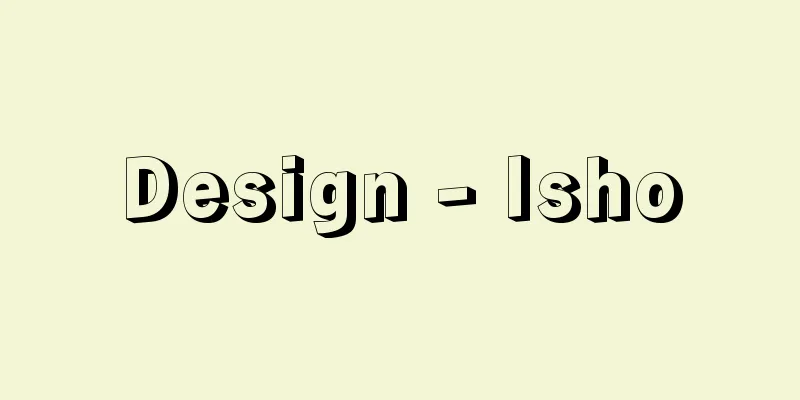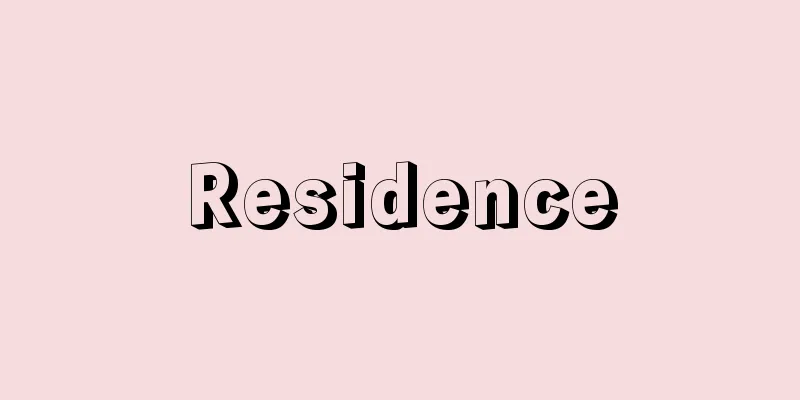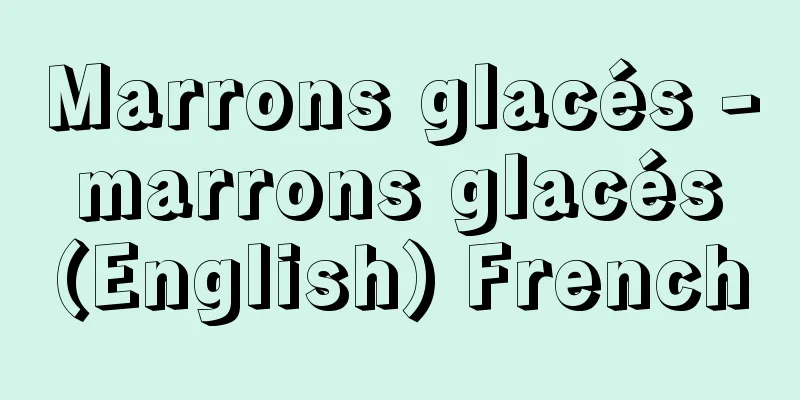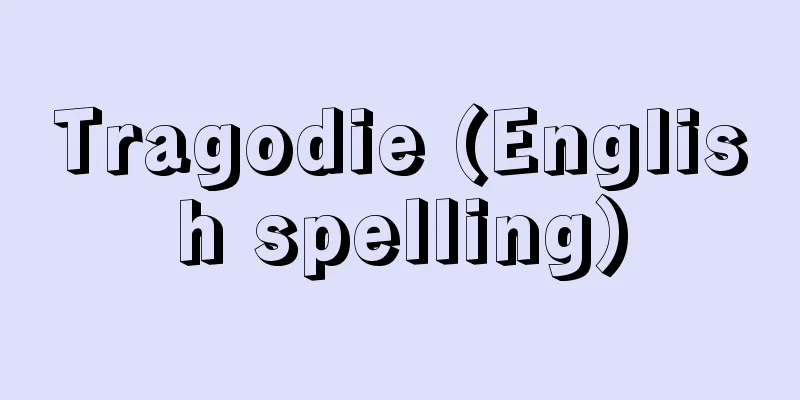Design - Isho

|
Generally speaking, it means decoration or a design, and is a translation of the English word "design," but the term design is also used broadly to mean creations and blueprints related to shapes, such as the design of buildings or parks. Designs are legally protected and utilized as product designs under the Design Act, Copyright Act, Unfair Competition Prevention Act, etc. The importance of design is clear from the fact that, for example, if similar products on store shelves have similar performance, functionality, materials, and price, consumers' criteria for product selection will be limited to the quality of the design, such as color, shape, and pattern. Some product designs are protected as applied art under the Copyright Act and as product indications or product forms under the Unfair Competition Prevention Act, but their legal protection is mainly realized under the Design Act [Kadota Masayoshi, April 16, 2021] Design LawAs mentioned above, the design of a product serves as a criterion for consumers when selecting products, and is therefore an important management resource for companies. The origin of the design protection system is said to be in 1711 in Lyon, France, where the imitation of other people's designs in the silk weaving industry was prohibited. In 1787, the UK enacted an ordinance granting ownership of "designs for linen, cotton goods, calico and muslin". In 1842, the US included provisions for design patents as part of its patent law, and in 1988, the UK's Copyright, Designs and Patents Act introduced unregistered design rights, and protection through the so-called "patent approach" and "copyright approach" was carried over to the European Community Design Regulation of 2001. The protection of designs in Japan began with the Design Ordinance of 1888 (Meiji 21), and was revised in 1899, 1909 (Meiji 42), 1921 (Taisho 10), and other times before the current law (Act No. 125 of 1959) was enacted. The current Design Act states that its purpose is "to encourage the creation of designs by promoting the protection and utilization of designs, thereby contributing to the development of industry" (Article 1 of the same Act). In 1998 (Heisei 10), a major revision was made to strengthen the protection of creative designs and to respond to internationalization, and in the 2019 (Reiwa 1) revision, protection was expanded to include image designs and spatial designs, which came into effect in April 2020. Internationally, the Paris Convention for the Protection of Industrial Property (International Convention for the Protection of Industrial Property, or Paris Convention), to which Japan is a party, and the Agreement on Trade-Related Aspects of Intellectual Property Rights (TRIPS Agreement), also contain provisions regarding designs. A design protected by the Design Act is "the shape, pattern, color, or combination of these (hereinafter referred to as "shape, etc.") of an article (including parts of an article; the same applies below), the shape, etc. of a building (including parts of a building; the same applies below), or an image (including parts of an image, limited to those used for operating equipment or those displayed as a result of an equipment performing its function; <omitted below>) that evokes a sense of beauty through the eye" (Article 2, Paragraph 1 of the Design Act). Until the 2019 amendment, designs were not protected if they were not "articles" and designs were considered to exist apart from articles (academic theory called the inseparability of designs and articles). However, with this amendment, the protection of "images" was limited to display images and operation images recorded and displayed on articles before the amendment, but after the amendment, display images and operation images themselves, such as icons recorded on the cloud, are protected regardless of whether they are recorded or displayed on articles. However, images that are not related to the functions of the devices to which the images are related, such as decorative images such as wallpapers on smartphones, and content images in movies and games, are not protected even after the amendment. In addition, before the amendment, "buildings" were considered to mean "tangible movable property" and could not be protected by design rights, but the amendment means that "buildings" (real estate) can also be protected by design rights. Furthermore, before the amendment, interior designs consisting of multiple items (tables, chairs, lighting fixtures, etc.) or buildings (wall and floor decorations) could not be registered as designs, but the amendment means that interior designs consisting of multiple items, buildings, and images can be registered as single designs only if they meet the requirement that "the interior as a whole creates a unified aesthetic impression." In addition, partial designs and designs for sets (system designs) are also included in designs protected by the law. [Masayoshi Tsunoda April 16, 2021] Design registrationTo register a design, the purpose of the created design of the article (or part of an article) or the building or image to which the design pertains is clarified, and an application for design registration is filed with the Japan Patent Office after preparing an application form and drawings (photographs or samples can be used instead) as prescribed by the Design Act and its Enforcement Regulations. If, after examination, the design meets the registration requirements stipulated in the Design Act, such as novelty and difficulty to create, it is registered as a design right in the register and published in the Design Gazette. [Masayoshi Tsunoda April 16, 2021] Design rightsA type of industrial property right. Like other industrial property rights such as patents and utility models, it is an exclusive right to registered designs, and the holder of the design right has the exclusive right to work the registered design and similar designs as a business. The duration of the design right was previously 20 years from the date of registration, but was extended to 25 years from the date of application by the 2019 amendment. As a property right, it can be transferred, inherited, licensed, and secured. In civil cases, design rights are allowed to be infringed with injunctions, damages, unjust enrichment, and credit restoration measures. In criminal cases, the previous penalty was imprisonment of up to three years or a fine of up to 3 million yen, or both, but was increased to imprisonment of up to 10 years or a fine of up to 10 million yen, or both, by the 2006 amendment. Infringement of design rights is a non-complaint offense. The trends in the number of design applications and registrations in Japan over the past five years are as follows: ●2015 Number of applications: 30,419 "Article-by-Article Commentary on the Industrial Property Law (Industrial Property Rights Law)" edited by the Japan Patent Office, 21st Edition (2020, Japan Institute of Invention and Innovation)" ▽ "Intellectual Property Law" by Masayoshi Kakuta and Naohiko Tatsumi, 9th Edition (2020, Yuhikaku)" [References] | | |Source: Shogakukan Encyclopedia Nipponica About Encyclopedia Nipponica Information | Legend |
|
一般には装飾、図案などを意味し、英語のデザインdesignの訳語であるが、デザインという用語は、広く建築や公園のデザインのような造形に関する創作、設計案などを意味する場合にも用いられる。 意匠は、法的には商品のデザインとして意匠法、著作権法、不正競争防止法などによりその保護利用などが図られている。意匠の重要性は、たとえば、店頭に並んでいる同種商品の性能、機能、材質および価格などが同程度であれば、需要者の商品選択の基準は色彩、形状、模様などデザインの良否に絞られることから明らかである。商品のデザインは、著作権法における応用美術として、また不正競争防止法における商品等表示ないし商品形態として保護されるものがあるが、その法的保護はおもに意匠法によって実現されている 意匠法前述のように商品のデザインとしての意匠は、需要者の商品選択の基準となるから、企業にとっては重要な経営資源となる。 意匠の保護制度の起源は、1711年フランスのリヨンで絹織物業界における他人の図案の模倣を禁止したことであるといわれている。1787年イギリスでは「麻布、綿製品、キャラコおよびモスリンの意匠」に所有権を与える条例が制定された。1842年アメリカでは特許法の一部に意匠特許の規定がおかれ、1988年イギリスの「著作権、意匠および特許法」では、未登録の意匠権が導入され、いわゆる「パテントアプローチ」と「コピーライトアプローチ」による保護が、2001年の「欧州共同体意匠規則」に引き継がれている。 日本における意匠の保護は、1888年(明治21)の「意匠条例」に始まり、1899年、1909年(明治42)、1921年(大正10)などの改正を経て1959年(昭和34)に現行法(昭和34年法律第125号)が制定された。 現行の意匠法は、「意匠の保護及び利用を図ることにより、意匠の創作を奨励し、もつて産業の発達に寄与することを目的とする」と定めている(同法1条)。1998年(平成10)に創造的デザインの保護強化と国際化に対応する大幅な改正が行われ、2019年(令和1)の改正では、画像デザインと空間デザインにも保護が拡張され、2020年4月から施行されている。 また国際的には、日本も加盟している「工業所有権の保護に関するパリ条約」(工業所有権保護同盟条約、パリ条約)や「知的財産権の貿易関連の側面に関する協定(TRIPS(トリップス)協定)」にも意匠に関する規定がおかれている。 意匠法によって保護される意匠は、「物品(物品の部分を含む。以下同じ)の形状、模様若(も)しくは色彩若しくはこれらの結合(以下「形状等」という)、建築物(建築物の部分を含む。以下同じ)の形状等又は画像(機器の操作の用に供されるもの又は機器がその機能を発揮した結果として表示されるものに限り、画像の部分を含む。<以下省略>)であつて、視覚を通じて美感を起こさせるものをいう」である(同法2条1項)。 2019年の改正までは「物品」でないものは保護されず、意匠は物品を離れては存在しないとされてきた(学説上、意匠と物品の不可分性とよばれた)。しかし、この改正により、「画像」の保護は、改正前には表示画像および操作画像のうち物品に記録・表示される画像に限られていたのが、改正後は物品に記録・表示されているか否かにかかわらず、クラウド上に記録されたアイコンのような表示画像や操作画像そのものを保護することとなった。もっとも、スマートフォンなどの壁紙等の装飾的な画像、映画・ゲーム等のコンテンツ画像のような、画像が関連する機器等の機能に関係のない画像については、改正後も保護されるわけではない。また「建築物」は、改正前に「物品」は「有体物である動産」を意味するとされて、意匠権で保護することはできなかったが、改正により「建築物」(不動産)についても意匠権で保護することができることとなった。さらに、改正前は複数の物品(テーブル、椅子、照明器具など)や建築物(壁や床の装飾)から構成される内装のデザインは、意匠登録を受けることができなかったが、改正により複数の物品や建築物、画像から構成される内装のデザインについても、「内装全体として統一的な美感を起こさせる」という要件を満たす場合に限り、一意匠として意匠登録を受けることができることとなった。このほか、法律上保護される意匠には部分意匠、組物の意匠(システムデザイン)も含まれる。 [角田政芳 2021年4月16日] 意匠登録意匠の登録は、創作された意匠に係る物品(物品の部分でもよい)または意匠に係る建築物もしくは画像の用途を明らかにし、意匠法、同施行規則などが規定する願書、図面(写真や見本でも代用できる)などを作成して特許庁に意匠登録出願をし、審査の結果、意匠法に定める新規性や創作非容易性などの登録要件を具備している意匠は、意匠権として登録原簿に設定登録され、意匠公報によって公開される。 [角田政芳 2021年4月16日] 意匠権産業財産権(工業所有権)の一つ。特許権、実用新案権など他の産業財産権と同様に登録意匠に対する排他的独占権であり、意匠権者は業として登録意匠およびこれに類似する意匠の実施をする権利を専有し、存続期間は、従来登録の日から20年であったが、2019年改正法により、出願から25年に延長された。財産権として、譲渡、相続、実施許諾、担保権設定が可能であり、意匠権の侵害に対しては、民事上は、差止請求権、損害賠償請求権、不当利得返還請求権および信用回復措置請求権などが認められ、刑事上は、従来3年以下の懲役もしくは300万円以下の罰金またはその併科であったが、2006年改正法により10年以下の懲役もしくは1000万円以下の罰金またはその併科に引き上げられた。なお、意匠権侵害罪は非親告罪である。 日本における意匠の出願件数および登録件数の過去5年間の推移は以下のとおりである。 ●2015年 『特許庁編『工業所有権法(産業財産権法)逐条解説』第21版(2020・発明推進協会)』▽『角田政芳・辰巳直彦著『知的財産法』第9版(2020・有斐閣)』 [参照項目] | | |出典 小学館 日本大百科全書(ニッポニカ)日本大百科全書(ニッポニカ)について 情報 | 凡例 |
Recommend
Emden Conference - Emden Conference
A conference of the Reformed Church held in Emden ...
Matsudaira Sadamasa
Year of death: 24th November 1673 (11th January 16...
berkelium
Bk. Atomic number 97. Group 3 actinide element wi...
Grunitzky, N.
...Meanwhile, an autonomous government was establ...
Eyelashes - eyelashes (English spelling)
Some mammals have hairs on the upper and lower eye...
《Siyāsat nāma》(English spelling)
…One of his efforts was to establish Nizamiya sch...
Iwatoyama
...It is also known as a town of sailors, with ma...
Pterygolepis (English spelling)
A fish of the Pterygolepididae family of the Birke...
Rudrāmbā (English spelling) Rudramba
…The dynasty reached its zenith during the long r...
General union - Ippan Kumiai (English spelling) general union
A broad organization of unskilled workers across ...
Torque converter - Torque converter
A device that transmits power from one shaft to a...
Janneau, G.
...Then, in the second half of the 19th century, ...
Donati, G. (English spelling) DonatiG
…It is a ceramic pneumatic instrument shaped like...
Gymnogongrus flabelliformis Harv.
A red alga of the Celastraceae family (illustratio...
Whitlam
Australian politician. Born in Melbourne, graduate...



![Satsuma [town] - Satsuma](/upload/images/67cbac500e0ea.webp)





